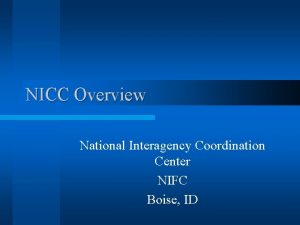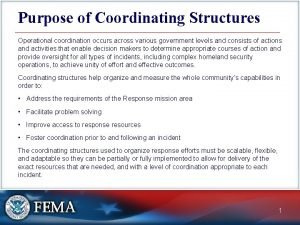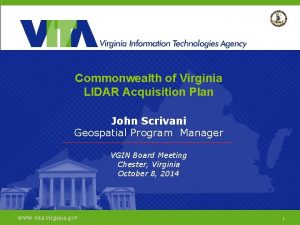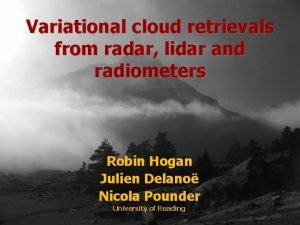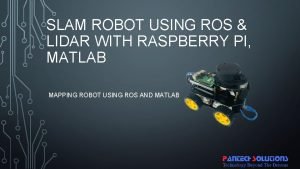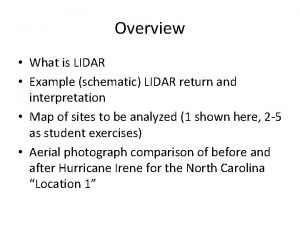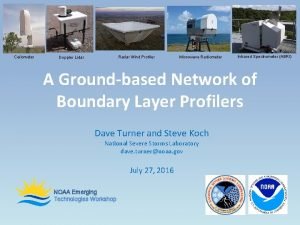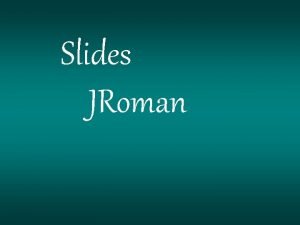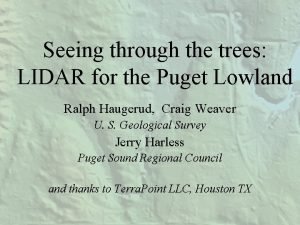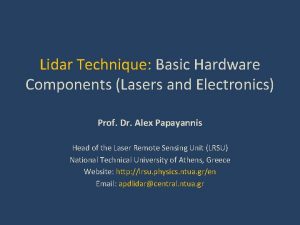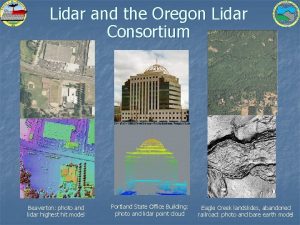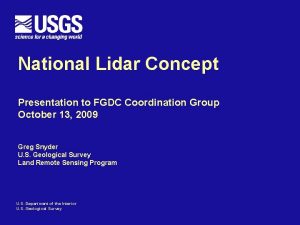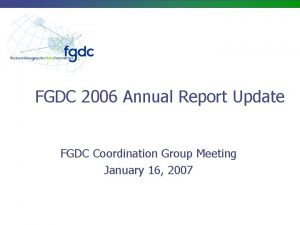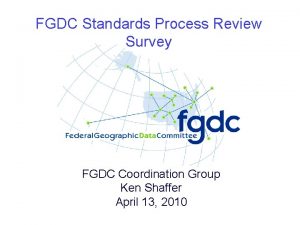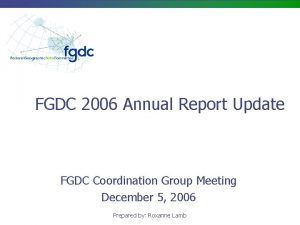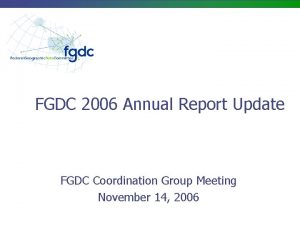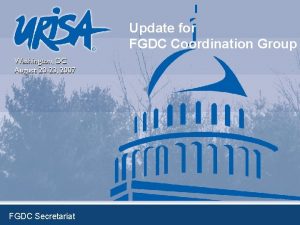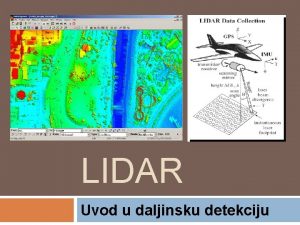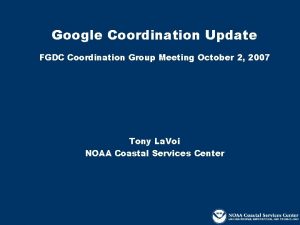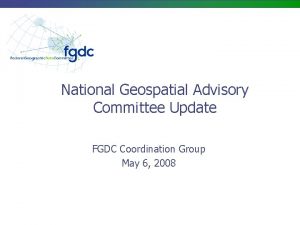National Lidar Concept Presentation to FGDC Coordination Group













- Slides: 13

National Lidar Concept Presentation to FGDC Coordination Group October 13, 2009 Greg Snyder U. S. Geological Survey Land Remote Sensing Program U. S. Department of the Interior U. S. Geological Survey

Briefing Outline § § Lidar technology and applications Why a National Lidar program / data set Coordinating National Lidar Next steps 2

Lidar - What Is It Basic components • Laser scanner • GPS • Inertial Navigation System • Terrestrial, airborne or space platforms Laser scanner • Emits laser beams at high frequency • Measures RT travel time of pulses from sensor to surface • Up to 200, 000 pulses per second Typical Aircraft Mission • Speeds of 50 -200 knots • Heights of 100 to 5, 000 meters Requirements • Mapping, forestry, resource management, climate science, etc. . . Resolutions/accuracies • From centimeters to tens of meters 3

Lidar Platforms 4

Why a National Lidar Dataset is Needed § Upgrade the National Elevation Dataset (NED) which is often of lower accuracy than required • • Average NED RMSE is approximately 2 -meters FEMA guidelines for flood hazard mapping require 18 cm RMSE § 3 -D data for vegetation and built-up features has never been widely collected § Existing data lidar collections are not consistent across projects § The community is looking for systematic, consistent, multipurpose base data set 5

Mapping Applications from Lidar Orthoimagery Land Cover Lidar Bare Earth Elevation Structures Contours Hydrology 6

Range of Potential National Lidar Applications Volcano monitoring Vegetation / Biomass Earthquake faults Land Cover Hydrologic Studies Urban / Suburban Response Coastal Studies Carbon / 7 Disturbance studies

National Lidar Programmatic Goals § § § Leverage and expand ongoing Federal and State activities towards national coverage Gain efficiency / economies of scale to meet interdisciplinary agency mission needs Expand Federal and State partnerships and stakeholder interaction § Work from a structured business plan (requirements, cost/benefit, project design, technology data mgt) § § Maximize commercial sector involvement § Promote expanded applications Seek best available operational technologies to reduce cost and collection time 8

Data Goals § § § Nationally consistent 3 -D measurements of terrain, vegetation and built-up features Consistent methodology and specifications to match measurements between projects Flexibility to accommodate variations in regional needs (topography, land cover, etc. ) Retains and delivers all data for multiple applications (bare-earth, vegetation, structures, etc. ) Requirements-driven data refresh cycle Public domain and readily available 9

Stakeholders § § § Federal players include USGS, FEMA, NOAA, USDA, USACE, NASA, NGA… States, local, tribal governments Organizations: § AASG § NSGIC § ASPRS, AAG, etc § MAPPS § Science consortiums § Others… 10

Coordination Options and Approaches § § § Possibly form a new Federal lidar coordination group Leverage the interagency National Digital Elevation Program (NDEP) § NDEP agencies coordinate operational elevation programs today Gain executive-level visibility and support from FGDC § Regular updates and discussions with FGDC § National Geospatial Advisory Committee (NGAC) FACA provides Non-Federal views and recommendations Interact directly with State and local organizations Interact broadly with stakeholders at public / professional meetings and individually 11

Summary and Observations § There is strong stakeholder interest in a national lidar data set for topographic and non-topographic applications § It is important to retain the full lidar data set for interdisciplinary applications § A formal interagency process and structured National Lidar business plan is needed § There is great benefit (and complexity) in blending national requirements, funding and priorities § Partner involvement may include data, funding, technology, applications, etc. § Industry’s implementation capability is significant 12

FY 2010 § § § Fund a National Lidar study (cost / benefit, project design, etc. ) Refine interagency and other stakeholder coordination mechanisms Recommend a long-term national lidar program 13
 M(aa)3 isomers
M(aa)3 isomers Concept de coordination
Concept de coordination National interagency coordination center
National interagency coordination center How do coordination structures help organize
How do coordination structures help organize Virginia lidar
Virginia lidar Radar lidar
Radar lidar Lidar raspberry pi
Lidar raspberry pi Lidar schematic
Lidar schematic Laser and radar difference
Laser and radar difference Lidar wind profiler
Lidar wind profiler Pessoas grossas
Pessoas grossas Puget sound lidar consortium
Puget sound lidar consortium Lidar system component
Lidar system component Dogami lidar
Dogami lidar


